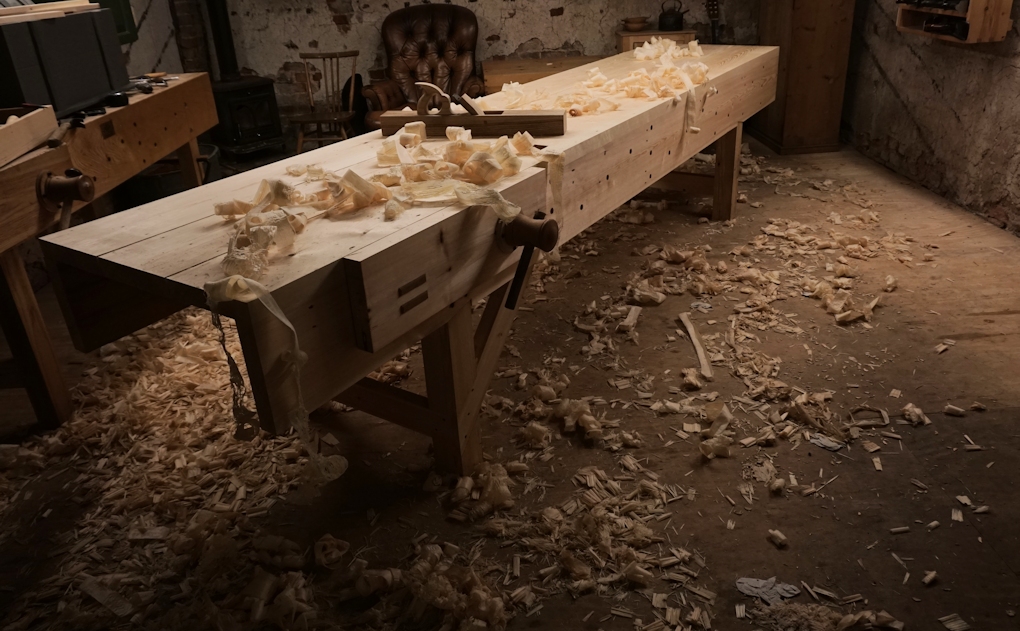 Sorry if I sound like a feminist, but I feel that liberate is a good word to go with.
Sorry if I sound like a feminist, but I feel that liberate is a good word to go with.
I’ve been told it’s ironic to watch my way of woodworking, whilst at the same time knowing that I build fancy workbenches.
Admittedly I’m a bit rough and brutish using my own bench, sticking stuff in to the top and whatever it takes to get a job done.
I would call it being efficient, and I think having what some might call a disrespectful attitude towards your workbench, is as vital to my work flow as having sharp tools.
Even a beautiful bench can only be functional when we view it as a tool, and I’ve always encouraged people to speed along making their first scratch on a bench even if it’s posh. A workbench is not a workbench until it has dents and scuffs and blood.
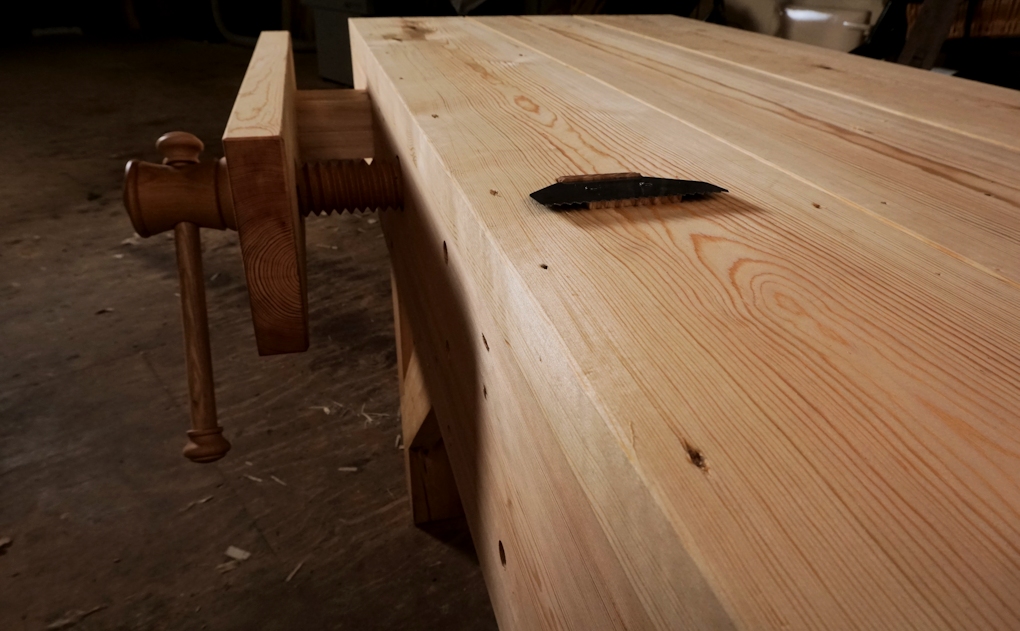
Our English Workbench build is ideal if you’re looking to build with minimal tools. If you’re in need of building yourself a stout workbench, then check out the Video Series Here
Working by hand is laborious, so we all know to go about it with properly set tools and a good bench.
What doesn’t get talked about so much is you being a tool. I’m not insulting you there, just pointing out that as much consideration needs to go in to setting you up as every other tool in the box.
Your stance, your movements. They’re both a huge part of your work flow, but the real thing I’m getting at here is attitude.
We don’t work well if we’re unconfident, and we need to gain this with time (my first successful sharpen as my old man’s skivvy, was only after I had lost my rag for not being able to do it!).
And these same restrictions of having no confidence can come from being too precious about our bench and tools.
If your workbench is unscathed and shiny, then I’m sorry to tell you it may be the most under utilised tool that you own. Maybe it’s time to liberate your woodworking and use that bench.
Pick up a hammer and whack something in it…
And if you don’t want to pointlessly deface your bench, you could wait until tomorrow instead, as we have a special guest article (I think that’s a first for us) and it will make this attitude become much more useful.

![Simple Work Holding For Ploughing Grooves [Without a Tail Vice]](https://www.theenglishwoodworker.com/wp-content/uploads/2022/07/workholding-without-tail-vice-copy.jpg)
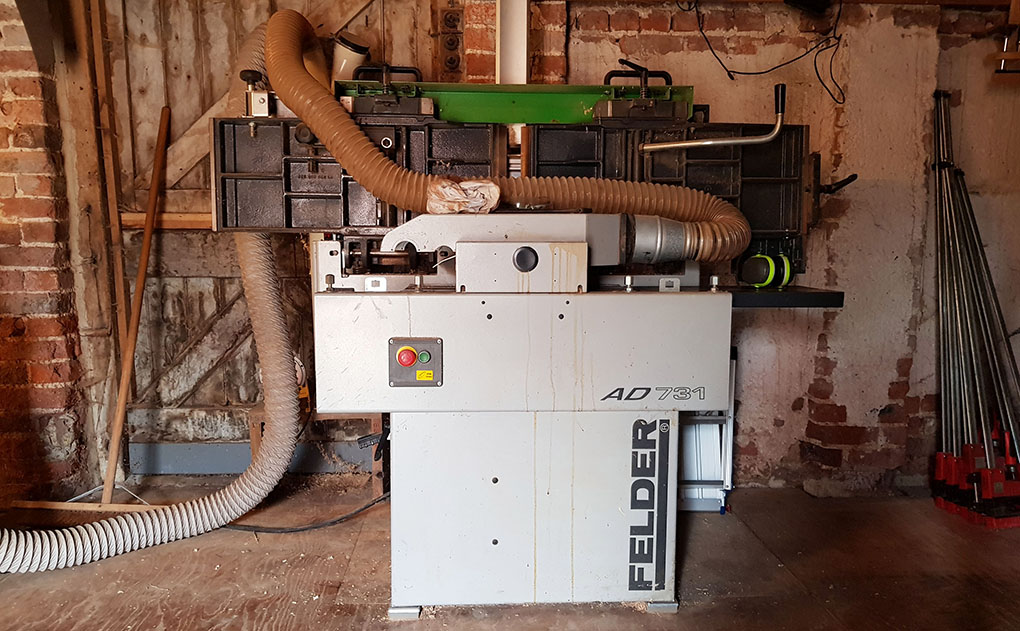
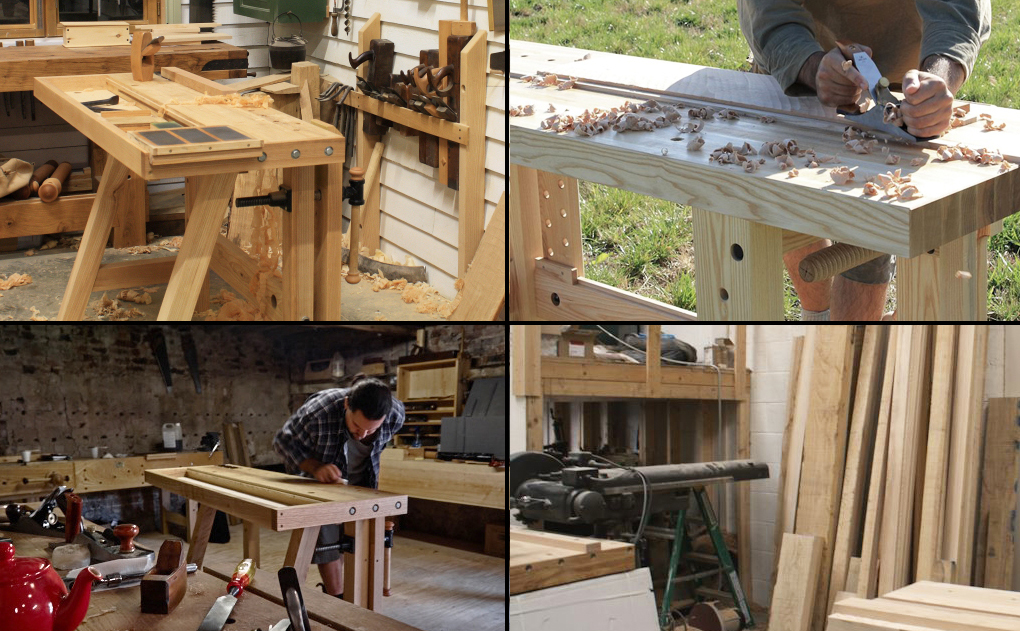
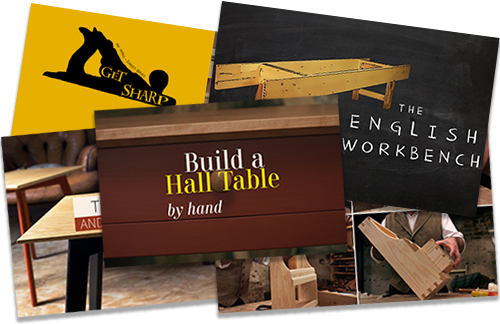
Thanks for this Richard. So, so true, especially about ‘using’ ourselves. I find that so often I’m the most under utilized tool I’ve got. Then I DO feel like a tool!
Cheers Peter, you should never underestimate the work holding ability of a head 😉
I agree. My workbench has to be scraped down at least once a week, or nothing that I build would be square.
It sounds like you spread glue like me then. I often find dried on glue and other additions to be more of a hindrance than a battered and bruised bench top.
No need to apologize for sounding like a feminist. I feel pretty cool with allowing half the world’s population a representative voice in government and equal pay for equal work.
Great to see a new post.
Well, my bench of yours does not have many dings on it yet, but I find the worse thing is glue drips, still I find a regular coat of Danish oil applied makes it easy to get off, you cant beat a good solid bench base, and yours are solid!
Cheers Chris, yep the dreaded glue. I can understand why people go to the extreme of waxing their bench tops.
Hi Richard,
I was about to organize an Internet search party to look for you as we have not been fortunate to receive one of your blogs lately. So good to see you posting again and hope you and Helen are well.
All you say is true and my bench looks very used.
Mike O’Brien
Alabama, USA
Ha ha, thanks for thinking of us. We’re absolutely bedlam at the minute as we aim to get all of the workbench orders completed by the end of the year, as January will be a change of routine and much more blogging.
Also I feel a bit like Daddy Bloody Crimbo at the minute as I’m trying to get everybody’s bench ready for Christmas!
My workbench had cut marks, dings and gouges in it before I had even finished building it. It is not a pretty bench, but it is the center of my woodworking.
Ha ha, the bench in the photo got its first scar before it was finished, as I was sawing the vice handle and continued to the jaw.
So many years ago, I took my first woodworking class in a new school that had brand new benches. The teacher wanted to keep the benches new. So we all had to work on a piece of corrugated cardboard taped to the bench top. Not the best way, but I bet those benches still look like new.
I bet that was an experience, I’d hate to have been the first to have shoved a chisel in to the top!
I love the open honesty and leads me to my dilemma. I have looked longingly with much admiration at your benches, however as a home woodworker starting out it would have been an awefully big investment with money being very tight. Also I feel like many others I should build my own as againike others a right of passage. Spending a valuable thousand or so pounds in a bench then whacking the hell out of it never sat very comfortable. So a long winded way to ask what cheap material would u use to make a robust bench,able to mount a good vice to, but avoiding the ply lamination type such as paulk table design. Love the blog.
You can go to Paul Sellers’s website and make one of the benches he makes. Or look for Mike Siemsen’s “The Naked Woodworker” video. He makes a classic Nicholson style bench for CHEAP. I wish I’d made either of these models for my first bench. Now I’m stuck with two benches that I don’t love but that work well enough to get the job done. (I fortunately don’t feel any precious attachment to either of them!)
Shaun,
+1 on the Mike Siemsen DVD. AND, he has a YouTube video on work holding with this bench without vises which you might want to view before spending any money on a vise. The link to the YouTube video is :
https://m.youtube.com/watch?v=yvhn-PAfEW4
For someone starting out, they might be worth your time.
Patrick,
I am with you. I am getting close to finishing a Paul Sellers bench and plan on using holdfasts as demonstrated by Mike Siemsen. I will be backing up the laminated 2 by 4 apron with 1 by material to get the correct thickness. I am completely new to woodworking, so take anything I say with a grain to salt.
Hi Shaun, if you’re looking for the most affordable and suitable timber then you can’t really beat pine, and it has the bonus of being a doddle to build with. Don’t skimp on your vice through, there’s nothing worse!
We’ve got a lot of info on this exact subject coming in the following weeks, so bear with.
I once had a girlfriend that used to take her brand new car to the supermarket and run a shopping cart into it. She said it was liberating, not having to worry about the first ding.
Love that attitude, what a woman!
@Shaun,
The important things in a workbench are weight, stability and flatness. Apart from that, almost anything can be pressed into service. The best wood to use is whatever you can find within your budget. Many very good benches are built out of common construction grade softwood, about 3″ thick more or less. Many are laminated tops from 2″ x 3″ redwood. Look for clear wood if you can sort through it, i.e. without knots.
Softwood is fine. If you are fussy, you can glue hardwood edging to it, but I would worry about differential movement if you do that. Others get away with it.
Have a look at Paul Sellers on YouTube or his blog, he has done a cheap-to-build good English workbench.
Don’t skimp on the vice, bigger the better, – but there are many good old’uns on eBay.
Yes, anything goes. It should be built smart, not look smart.
Regarding hardwood: I built my bench from poplar plywood, with ash slats glued on top with MS polymer glue. That should allow for movement. This lamination is hard wearing, stays flat and can be re-flattened, dampens blows and keeps the cost down (a bit).
I’m with you Richard. I have not been brutal to my bench, but… you can tell it is a “work bench”. I built it this February and March. Three of my grand daughters and one grandson spent two weeks this last summer building a myriad of projects. I could not bring myself to scrape off any of the glue, paint, stain, shellac or chisel dings. My grandson drilled through the scrap wood he was using under the piece he was drilling for about a half inch. Every morning before even breakfast was made they were asking “Grampa, when can we go down to the workshop”? Every spill, scratch and ding brings back memories that are worth all of the battle scars. I love my bench, I built it myself. It is square, level, solid and beefy. It was beautiful when I built it, but even more so now that I have used it, and it shows.
Jimmy Brown
Canton, GA
What a wonderful comment, that made my day.
Thank you.
Your Grandkids will have those memories for the rest of their, lives as I do.
I very well remember being told by an old master woodworker that my Hands are my most precious tools. And that I should not beat them up. Being careful (Head) AND confident (Heart) helps a lot here.
Still, occasionally there’s blood on my bench. That’s all right. If it isn’t too much.
They sound like incredibly wise words, maybe I should take a leaf out of his book 🙂
But Richard, if you don’t want us to treasure our bench tops you shouldn’t make such beautiful ones!! Don’t get me wrong – I don’t mollycoddle it to the extent of not being able to work reasonably efficiently – but for me, working at a beautiful bench enhances the whole experience. Mine’s picked up some scuffs and scratches – but nothing’s been nailed to it and not likely to be for a good long time to come. You’re right of course that it does affect the workflow – and I’m lucky in that as a retired person I can afford to put pleasure before business when in the workshop. Part of that pleasure is that when I look down at the bench it gives me a good feeling! Long may that continue! 🙂
This post reminds me of a song (U Li La Lu) by one of my favorite bands (Poi Dog Pondering).
One of the lyrics is: “You should wear with pride the scars on your skin. They’re a map of your adventures and the places you’ve been.”
I think the same holds true for benches.
USING tools is a large part of having them. For many years I’ve told people I could not stand to drive a new pickup truck that didn’t have a load of gravel dumped unceremoniously in the bed and chains drug across the fenders. THEN it would be a working truck.
As a metalworker our benches are often used as temporary bending, welding and assembly fixtures. We weld blocks to the surface, grind radii on corners and drill occasional holes. All is fair as long as when you are finished you knock off the blocks, grind flush any welds, fill holes and rebuild corners. All these changes makes mild steel the preferred metalworking bench top material. After 30 years of such use you cannot tell my heavy welding bench has been used.
So it is not just woodworkers that need to work liberated.
I’ve used pine topped benches for decades in both my auto shop, blacksmith shop and for wood working. . On one occasion while rebuilding an automobile engine several quarts of motor oil were spilled on an unfinished pine bench. When the job was finished the bench was wiped down and a little saw dust spread on the surface. In a month or so the remaining oil had been sufficiently absorbed so that you could not see or feel it. The bench was used for decades more without staining anything used on it.
Pine and other softwoods have the ability to self heal small cuts with the grain and even small nail holes. It can also be patched and plugged relatively easily. Being soft it also does not mar or hurt other materials being worked on it. The perfect bench top material for liberated wood workers.
How true….
Glue spills and general gunk on the work surface is very easily removed if you treat the top with one of those lanolin based GEL (not liquid) concoctions used for cleaning and softening tack (horse leather things). Nothing seems to stick to a bench thus treated, and the surface is not wet or sticky – test first of course.